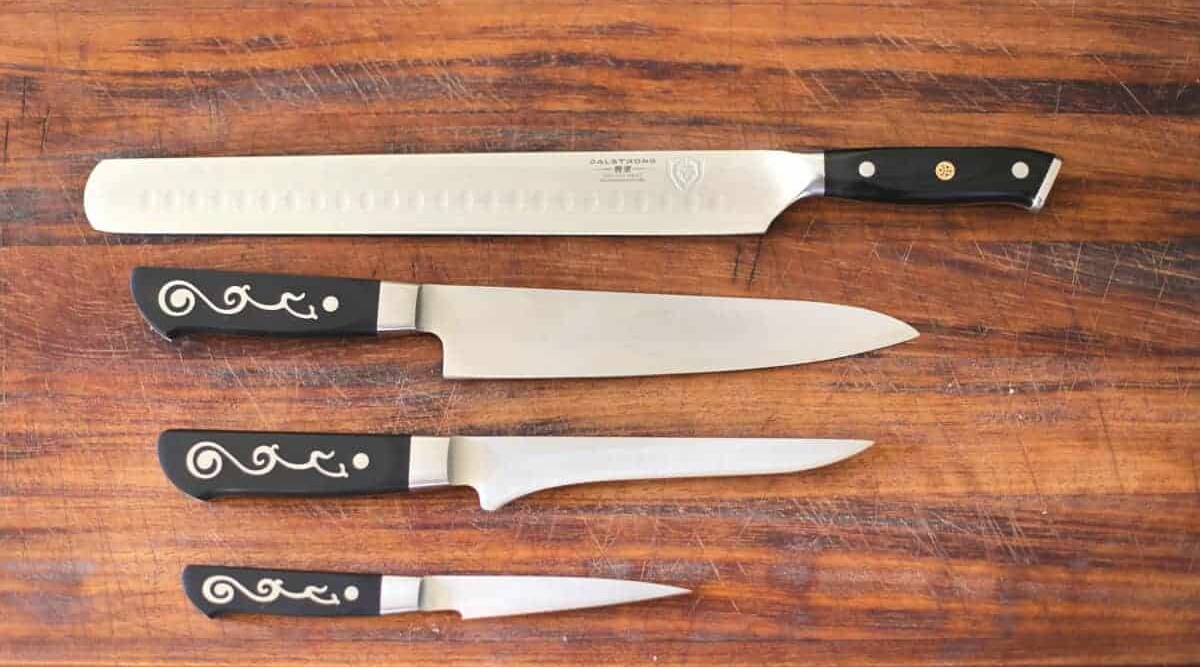
About 2.6 million years ago, someone figured out how to make a sharp edge from stone. Then, another genius learned how to make fire on demand, and the barbecue was born.
No longer did they have to roast whole mastodons by building a fire around it. Ancient barbecue chefs could now cut the meat into manageable pieces.
Knives have come a long way from their stone-aged predecessors. They’re still an essential tool for grilling, second only to fire itself.
We use knives to cut veggies, meat, and everything we need to make our barbecue complete.
You’ll find knives in different shapes and sizes depending on what you need to cut. They also range in the quality of the steel, handle material, and construction.
There are dozens of specialist knives available, to cover any conceivable job in food prep, butchery and eating that you can imagine. However, in our opinion, you only really need four knives to do a capable job at everything.
Keep reading to find out which four knives every BBQ chef should have.
Jump to:
- 1 First — A Knife’s Quality is Only as Good as the Steel
- 2 A Quick Lesson in Knife Terminology
- 3 The Chef Knife is the Backbone of Kitchen Cutlery
- 4 The Boning Knife Is a Must for Deboning and Butterflying
- 5 The Slicing Knife for Perfect Presentation
- 6 The Unsung Hero of the Kitchen Drawer, The Paring Knife
- 7 If You Have Knives, You Need to Keep them Sharp
- 8 Invest in the Best Quality Knives You Can Afford and Take Care of Them
First — A Knife’s Quality is Only as Good as the Steel
You’ll find a variety of materials used to make professional knives, but steel is the metal of choice. And the harder the steel, the longer the blade stays sharp.
To measure the hardness of steel, they use the Rockwell C scale (HRC). Look for a range of 52 to 60.
Although harder steel will hold an edge longer, it can make the steel brittle and prone to chipping and breaking.
If you tend to be tough on knives, buy a knife with softer steel that won’t chip or break. The steel will be a bit more flexible and forgiving.
Steel is the most common blade material, and it comes in two alloys, carbon steel, and stainless steel.
- Carbon steel — Harder than stainless, but it will stain when cutting acidic ingredients like lemons, onions or tomatoes. It’s made mostly of iron, carbon and one or more other alloys. Carbon knives keep a razor-sharp edge for a long time. However, they rust quickly and must be kept clean and oiled.
- Stainless Steel — The most popular alloy because it does not stain or discolor. Lower grade alloys do not hold an edge very long, but the knives are inexpensive. Some stainless steel is almost as hard as carbon steel. Look for AUS6 or 440A if you have a choice.
I’m mentioning ceramic as another material you’ll find in chef knives, but I don’t recommend it. Ceramic blades are harder than steel and hold an edge for a long time. However, they are brittle and can chip or break if you hit a bone or drop them. For that reason, I wouldn’t buy one as part of my top 4 knives.
A Quick Lesson in Knife Terminology
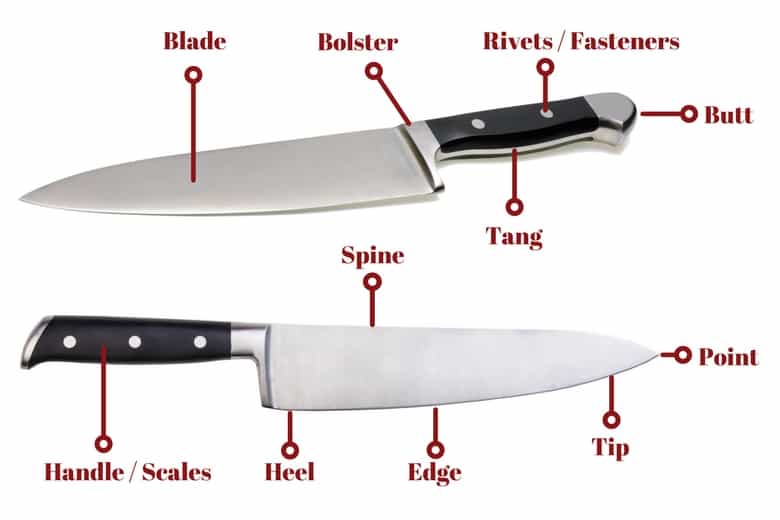
Before you go out to look for a quality knife, you need to know what you’re talking about. Here is the list of knife parts.
The steel portion of a knife has three sections, the blade, the bolster, and the tang.
The blade also has three parts starting with the tip, the middle section is the edge, and the rear portion is the heel.
The bolster separates the handle from the blade, and the tang is where the handle pieces (called scales) attach to the knife with rivets. Some handles are a one-piece molded plastic material instead of wood.
One more thing to consider is the blade style. Most knives have a straight edge. However, there are serrated and scalloped edges for sawing through tough or crusty food.
Now that you’re familiar with knife terminology let’s look at the four types of knives you need for your collection.
The Chef Knife is the Backbone of Kitchen Cutlery
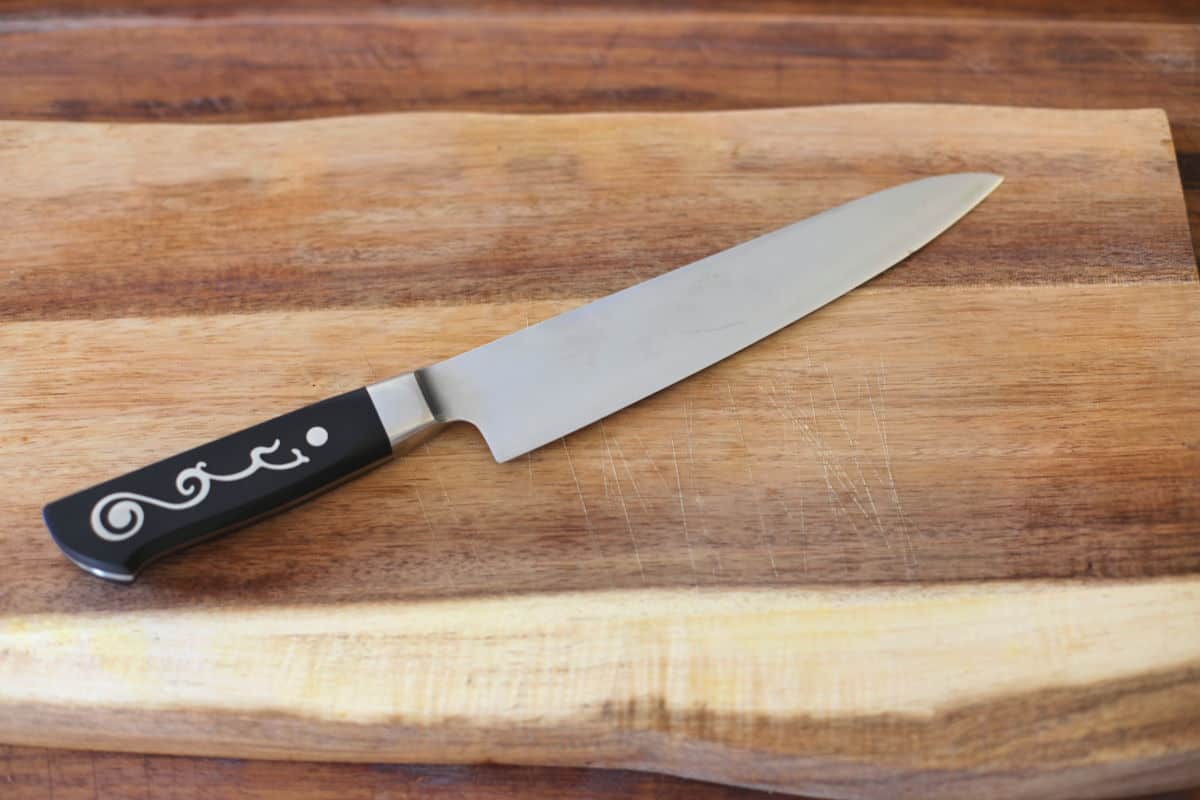
If you choose only one knife, the chef’s knife is the all-purpose tool that can do the job of almost any other knife. Use just the tip to make small slices, the edge for slicing and dicing larger objects and the heel for chopping.
The three most common lengths are 8, 10 and 12 inches. Most chefs prefer 10 inches if you’re only getting one knife. It’s comfortable to use for extended periods. If you use a 12-inch knife to cut everything, it’ll wear out your wrist, unlike the shorter blades. The 8-inch variety may be too short if you break down big cuts and too light for heavy-duty chopping, say 30 pounds of onions and carrots.
There are two main things to look for when buying a chef knife, the balance and blade width.
The knife should balance when you place the bolster on your finger. A properly balanced knife reduces hand fatigue if you do a lot of slicing and dicing because you’re using the weight of the knife instead of your wrist.
Choose the widest blade you can find. A wider blade allows you to chop thicker items and your knuckles won’t hit the cutting board.
You’ll find a quality chef knife for about $100, and it should last almost a lifetime with proper care.
Knives in the $50 range tend to have softer stainless steel and will not hold an edge as long, but still work well.
Don’t spend huge bucks for a quality knife. Anthony Bourdain prefers a Japanese chef knife by Global called the G-2 which is great value for money.
For a good quality, medium priced knife, look at the Victorinox 10 inch Fibrox Pro Chef’s Knife or the Mercer Culinary Renaissance 10-Inch Forged Chef’s Knife. These brands are a mid-range quality that you’ll find in just about any restaurant.
One way to tell quality steel is by listening to it when you flick it with your fingernail or ring. If the steel rings like a bell, it has a higher amount of carbon. That means it’s harder and will hold an edge longer.
A chef knife will do 90% of the cutting in your kitchen, but there are jobs where it’s not the best tool.
The Boning Knife Is a Must for Deboning and Butterflying
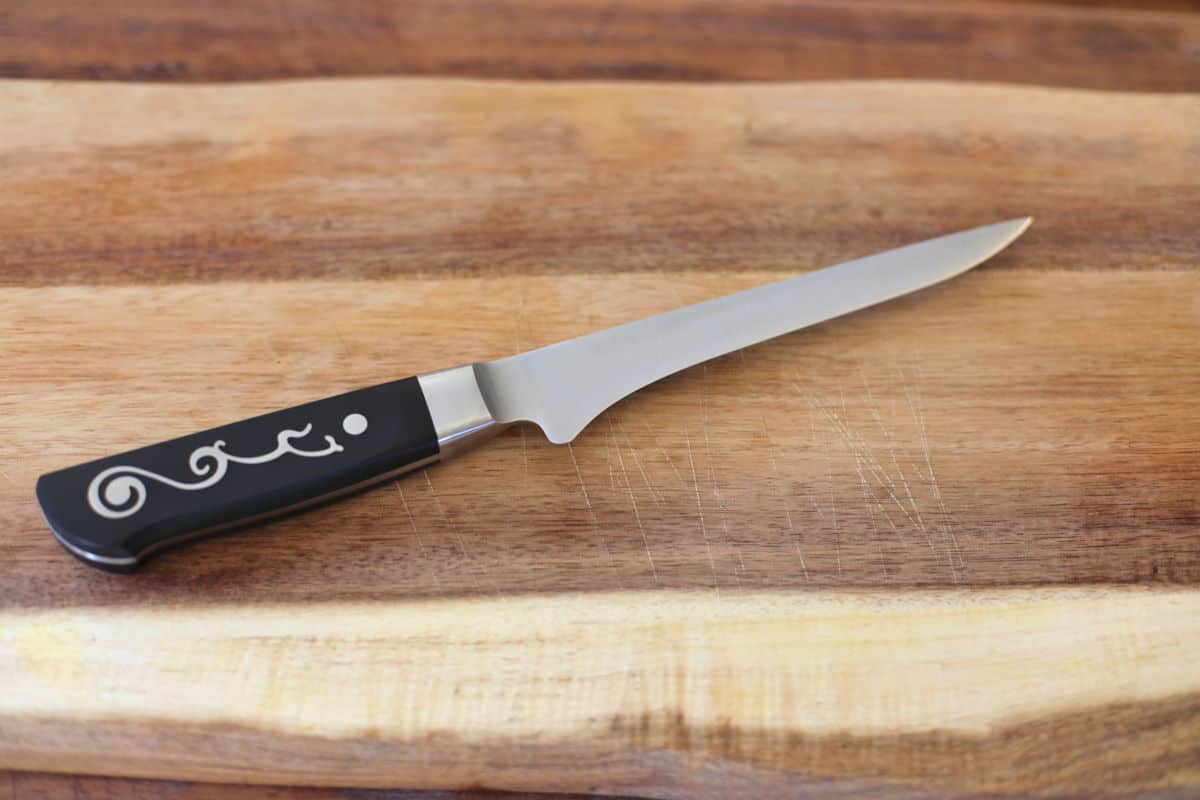
When it comes to separating meat from the bone, the right tool is the boning knife. It has a thin tapered blade and a sturdy handle.
“Boners” can be stiff or flexible, curved like a scimitar or straight. Their blades are typically 5 or 6 inches long.
For barbecue purposes, your best choice is a straight, stiff blade that will get in and around rib bones or the blade bone in pork shoulder.
You’ll mostly find two types of handles, wood, and plastic. Choose whichever feels better in your hand and go for the highest quality steel you can afford.
For a medium grade, try a Dexter-Russell 6-inch boning knife. It’s easy to clean and has an excellent grip to keep your hand from sliding up the blade.
For a high-quality boning knife, you can’t go wrong with a Zwilling J.A. Henckels. Zwilling is a well-known German manufacturer of high-carbon stainless steel knives.
The Slicing Knife for Perfect Presentation
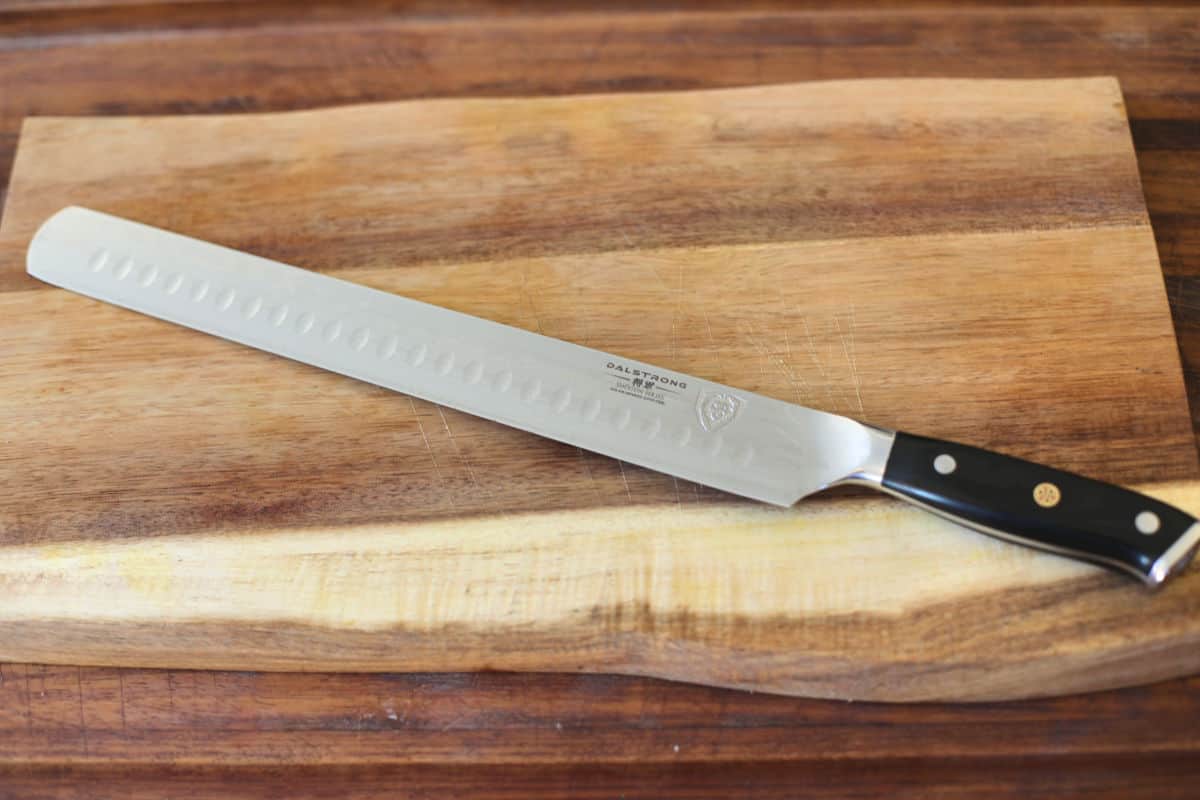
When you need to make uniform slices from large cuts like a whole top round or brisket, the slicing knife is the ideal tool.
Slicing knives are in the shape of a long rectangle, like a ruler, with a rounded tip. The better-quality knives have hollow ground air pockets or scallops to reduce drag. They help the knife make clean slices without shredding or tearing soft meat.
You may see the term Granton® edge to describe this type of blade.
There are three types of edges, straight, serrated and scalloped. Serrated blades are suitable for hard crusty bread but not good for soft brisket. Your best bet is the straight edge for clean slices.
Our personal favorite, especially for slicing brisket, is the Granton edge shogun series knife from Dalstrong.
The Unsung Hero of the Kitchen Drawer, The Paring Knife
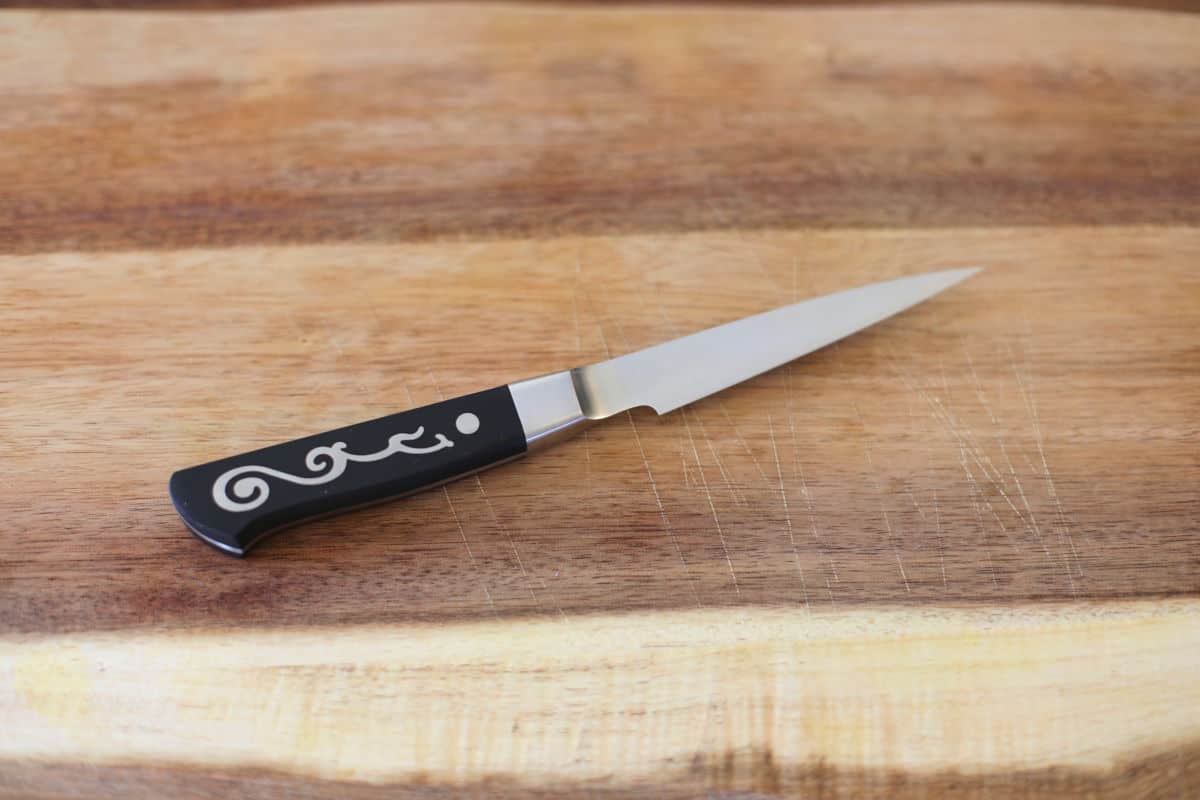
I use a paring knife for all the grunt work like cutting string, to open the packaging and peeling small veggies like onions and lemons.
The paring knife preserves the edge of your good knives by doing the tough utility cutting. The blade size is only 3 to 3 ½ inches, and they are relatively inexpensive to replace if they wear out.
Look for a knife with a more substantial, non-slip handle. In other words, don’t buy a cheap knife with a smooth plastic handle from the dollar store.
The real cheap knives get dull fast, and a dull knife is a dangerous knife. Victorinox and Dexter-Russel make good quality paring knives that you can find at any restaurant supply store.
If You Have Knives, You Need to Keep them Sharp
Sharp knives are easier to use and a joy to use, while dull knives are hard work and are even more dangerous. So once you have a set of good knives, you need to keep them sharp. You need a knife sharpener.
We have a handful of articles looking at different types of knife sharpeners, from your typical manual knife sharpener to electric knife sharpener reviews, and a tool for true edges in between sharpening with our winner looking for the best honing steel.
Check those guides out and pick up a sharpener to keep your knives in tip-top condition.
Invest in the Best Quality Knives You Can Afford and Take Care of Them
As with any tool, you get what you pay for. Choose the best quality steel for your knives because they will maintain a sharper edge longer. Always keep your knives clean, keep them sharp and in a protective sheath or covered knife rack.
Never wash your knives in a dishwasher because the heat and detergent will deteriorate the handles. Wash and dry them by hand. And hone them regularly between sharpening.
Your knives are essential to successful cooking and barbecuing. With proper care, they will last for years.
Let me know in the comments below which knife and brands you prefer, and why you chose them.
Happy grilling!


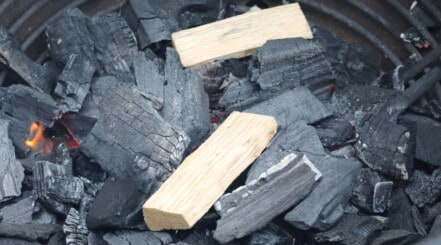
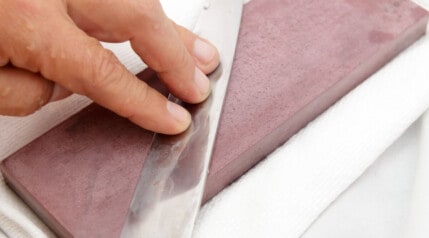
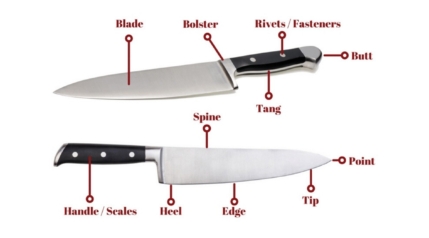
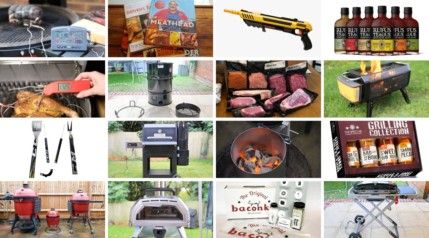
What brand are the Japanese looking knives in your pictures, the ones with the pattern in the handle?
They are: I.O. Shen Mastergrade, Japanese made knives, available mostly from the UK as they are based in London. Great quality, superb build quality, nicely balanced, super sharp, hold an edge well. I love ’em 🙂